Collaborative Overload: Problems, Solutions, and Leadership Report
VerifiedAdded on 2020/06/05
|8
|2250
|79
Report
AI Summary
This report delves into the topic of collaborative overload, a significant challenge in today's business environment marked by increased competition and globalization. It examines the pressures on employees, the importance of teamwork, and the role of leaders in mitigating stress. The report analyzes the key resources for building value through collaboration—informational, personal, and social—and identifies the problems associated with excessive collaboration, such as workflow issues and employee reluctance. It also explores solutions, including leadership strategies for managing collaboration and addressing workplace diversity. The report references several academic sources, providing a comprehensive overview of collaborative overload, its implications, and practical approaches to address related issues within organizations. It also provides answers to questions related to leadership roles, collaboration importance, associated problems, and workplace diversity solutions.
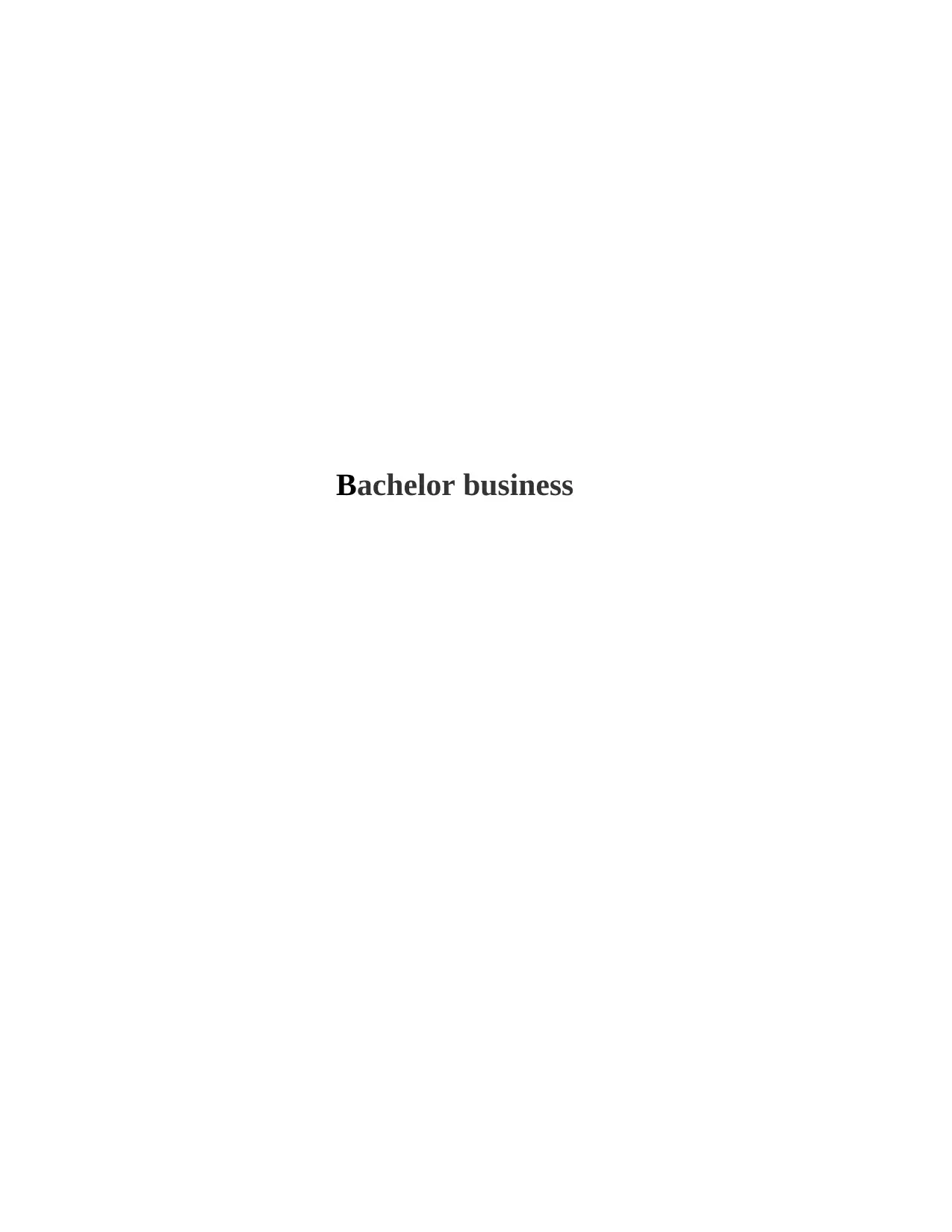
Bachelor business
Paraphrase This Document
Need a fresh take? Get an instant paraphrase of this document with our AI Paraphraser
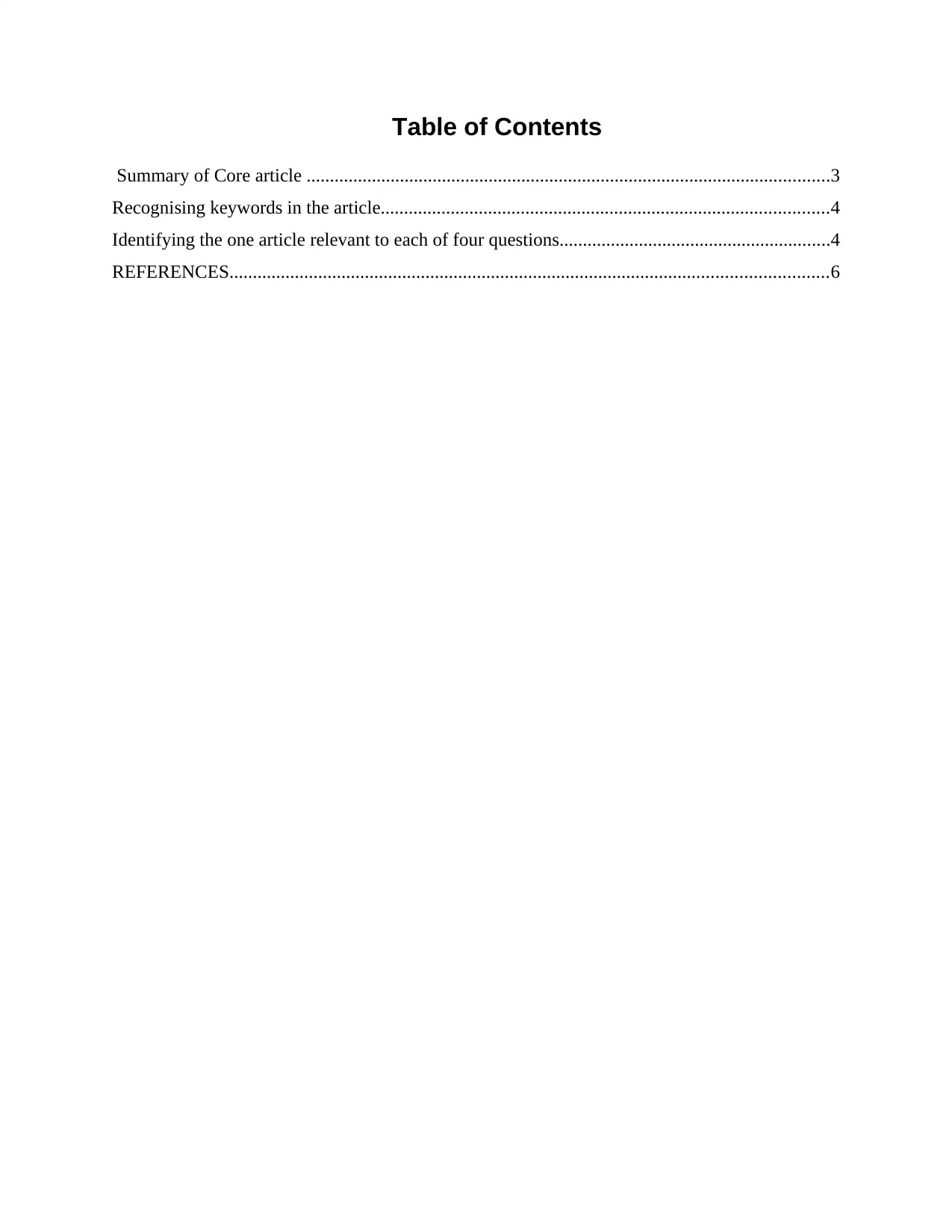
Table of Contents
Summary of Core article ................................................................................................................3
Recognising keywords in the article................................................................................................4
Identifying the one article relevant to each of four questions..........................................................4
REFERENCES................................................................................................................................6
Summary of Core article ................................................................................................................3
Recognising keywords in the article................................................................................................4
Identifying the one article relevant to each of four questions..........................................................4
REFERENCES................................................................................................................................6
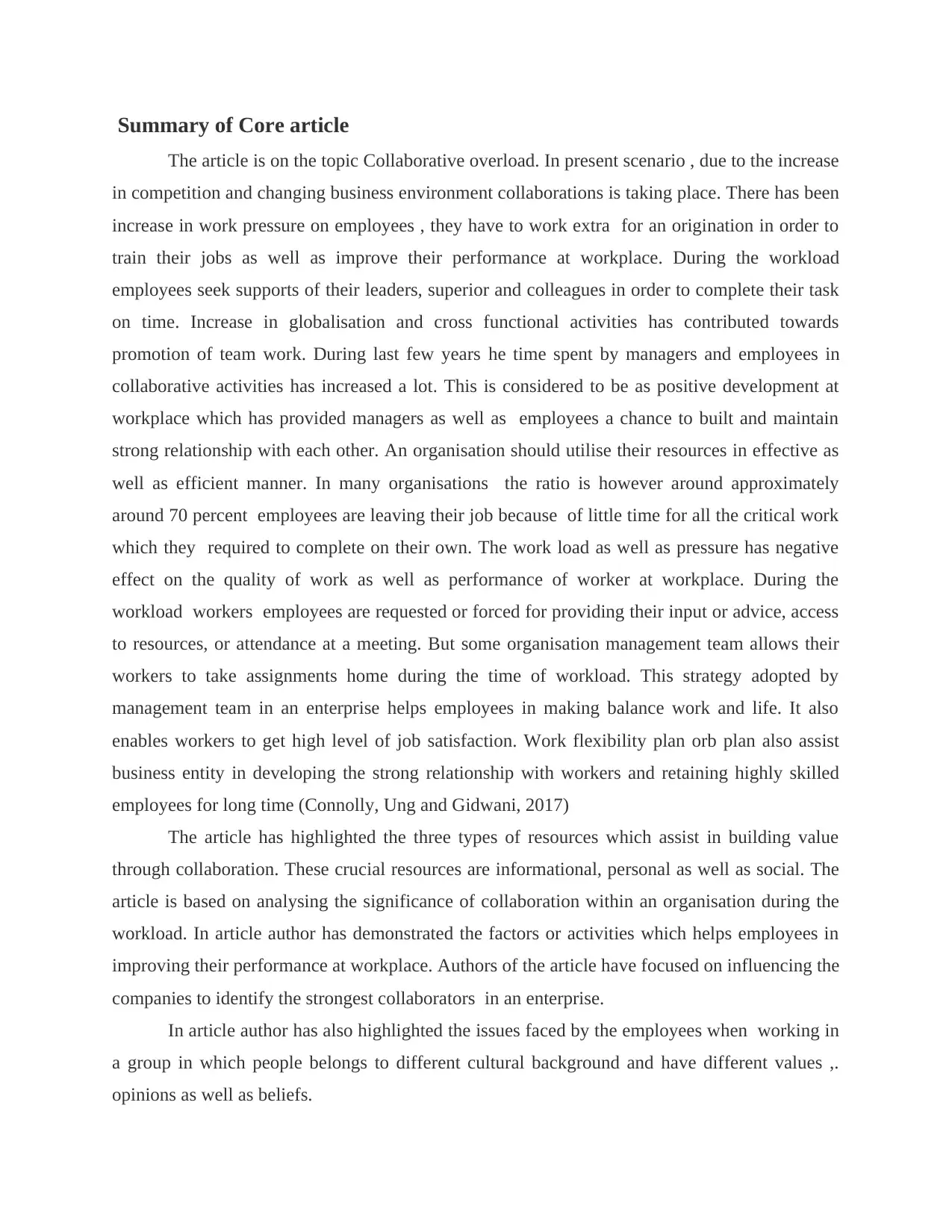
Summary of Core article
The article is on the topic Collaborative overload. In present scenario , due to the increase
in competition and changing business environment collaborations is taking place. There has been
increase in work pressure on employees , they have to work extra for an origination in order to
train their jobs as well as improve their performance at workplace. During the workload
employees seek supports of their leaders, superior and colleagues in order to complete their task
on time. Increase in globalisation and cross functional activities has contributed towards
promotion of team work. During last few years he time spent by managers and employees in
collaborative activities has increased a lot. This is considered to be as positive development at
workplace which has provided managers as well as employees a chance to built and maintain
strong relationship with each other. An organisation should utilise their resources in effective as
well as efficient manner. In many organisations the ratio is however around approximately
around 70 percent employees are leaving their job because of little time for all the critical work
which they required to complete on their own. The work load as well as pressure has negative
effect on the quality of work as well as performance of worker at workplace. During the
workload workers employees are requested or forced for providing their input or advice, access
to resources, or attendance at a meeting. But some organisation management team allows their
workers to take assignments home during the time of workload. This strategy adopted by
management team in an enterprise helps employees in making balance work and life. It also
enables workers to get high level of job satisfaction. Work flexibility plan orb plan also assist
business entity in developing the strong relationship with workers and retaining highly skilled
employees for long time (Connolly, Ung and Gidwani, 2017)
The article has highlighted the three types of resources which assist in building value
through collaboration. These crucial resources are informational, personal as well as social. The
article is based on analysing the significance of collaboration within an organisation during the
workload. In article author has demonstrated the factors or activities which helps employees in
improving their performance at workplace. Authors of the article have focused on influencing the
companies to identify the strongest collaborators in an enterprise.
In article author has also highlighted the issues faced by the employees when working in
a group in which people belongs to different cultural background and have different values ,.
opinions as well as beliefs.
The article is on the topic Collaborative overload. In present scenario , due to the increase
in competition and changing business environment collaborations is taking place. There has been
increase in work pressure on employees , they have to work extra for an origination in order to
train their jobs as well as improve their performance at workplace. During the workload
employees seek supports of their leaders, superior and colleagues in order to complete their task
on time. Increase in globalisation and cross functional activities has contributed towards
promotion of team work. During last few years he time spent by managers and employees in
collaborative activities has increased a lot. This is considered to be as positive development at
workplace which has provided managers as well as employees a chance to built and maintain
strong relationship with each other. An organisation should utilise their resources in effective as
well as efficient manner. In many organisations the ratio is however around approximately
around 70 percent employees are leaving their job because of little time for all the critical work
which they required to complete on their own. The work load as well as pressure has negative
effect on the quality of work as well as performance of worker at workplace. During the
workload workers employees are requested or forced for providing their input or advice, access
to resources, or attendance at a meeting. But some organisation management team allows their
workers to take assignments home during the time of workload. This strategy adopted by
management team in an enterprise helps employees in making balance work and life. It also
enables workers to get high level of job satisfaction. Work flexibility plan orb plan also assist
business entity in developing the strong relationship with workers and retaining highly skilled
employees for long time (Connolly, Ung and Gidwani, 2017)
The article has highlighted the three types of resources which assist in building value
through collaboration. These crucial resources are informational, personal as well as social. The
article is based on analysing the significance of collaboration within an organisation during the
workload. In article author has demonstrated the factors or activities which helps employees in
improving their performance at workplace. Authors of the article have focused on influencing the
companies to identify the strongest collaborators in an enterprise.
In article author has also highlighted the issues faced by the employees when working in
a group in which people belongs to different cultural background and have different values ,.
opinions as well as beliefs.
⊘ This is a preview!⊘
Do you want full access?
Subscribe today to unlock all pages.

Trusted by 1+ million students worldwide
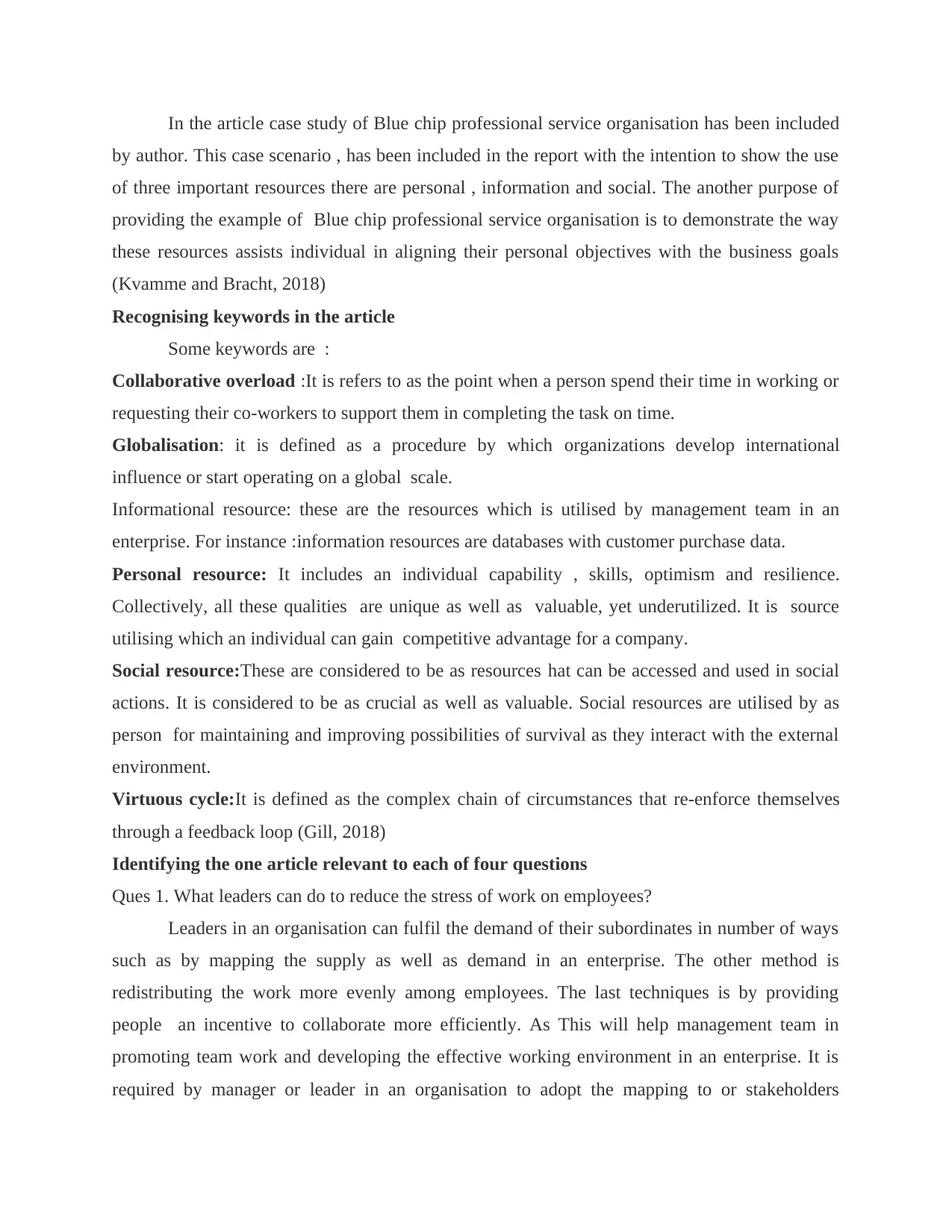
In the article case study of Blue chip professional service organisation has been included
by author. This case scenario , has been included in the report with the intention to show the use
of three important resources there are personal , information and social. The another purpose of
providing the example of Blue chip professional service organisation is to demonstrate the way
these resources assists individual in aligning their personal objectives with the business goals
(Kvamme and Bracht, 2018)
Recognising keywords in the article
Some keywords are :
Collaborative overload :It is refers to as the point when a person spend their time in working or
requesting their co-workers to support them in completing the task on time.
Globalisation: it is defined as a procedure by which organizations develop international
influence or start operating on a global scale.
Informational resource: these are the resources which is utilised by management team in an
enterprise. For instance :information resources are databases with customer purchase data.
Personal resource: It includes an individual capability , skills, optimism and resilience.
Collectively, all these qualities are unique as well as valuable, yet underutilized. It is source
utilising which an individual can gain competitive advantage for a company.
Social resource:These are considered to be as resources hat can be accessed and used in social
actions. It is considered to be as crucial as well as valuable. Social resources are utilised by as
person for maintaining and improving possibilities of survival as they interact with the external
environment.
Virtuous cycle:It is defined as the complex chain of circumstances that re-enforce themselves
through a feedback loop (Gill, 2018)
Identifying the one article relevant to each of four questions
Ques 1. What leaders can do to reduce the stress of work on employees?
Leaders in an organisation can fulfil the demand of their subordinates in number of ways
such as by mapping the supply as well as demand in an enterprise. The other method is
redistributing the work more evenly among employees. The last techniques is by providing
people an incentive to collaborate more efficiently. As This will help management team in
promoting team work and developing the effective working environment in an enterprise. It is
required by manager or leader in an organisation to adopt the mapping to or stakeholders
by author. This case scenario , has been included in the report with the intention to show the use
of three important resources there are personal , information and social. The another purpose of
providing the example of Blue chip professional service organisation is to demonstrate the way
these resources assists individual in aligning their personal objectives with the business goals
(Kvamme and Bracht, 2018)
Recognising keywords in the article
Some keywords are :
Collaborative overload :It is refers to as the point when a person spend their time in working or
requesting their co-workers to support them in completing the task on time.
Globalisation: it is defined as a procedure by which organizations develop international
influence or start operating on a global scale.
Informational resource: these are the resources which is utilised by management team in an
enterprise. For instance :information resources are databases with customer purchase data.
Personal resource: It includes an individual capability , skills, optimism and resilience.
Collectively, all these qualities are unique as well as valuable, yet underutilized. It is source
utilising which an individual can gain competitive advantage for a company.
Social resource:These are considered to be as resources hat can be accessed and used in social
actions. It is considered to be as crucial as well as valuable. Social resources are utilised by as
person for maintaining and improving possibilities of survival as they interact with the external
environment.
Virtuous cycle:It is defined as the complex chain of circumstances that re-enforce themselves
through a feedback loop (Gill, 2018)
Identifying the one article relevant to each of four questions
Ques 1. What leaders can do to reduce the stress of work on employees?
Leaders in an organisation can fulfil the demand of their subordinates in number of ways
such as by mapping the supply as well as demand in an enterprise. The other method is
redistributing the work more evenly among employees. The last techniques is by providing
people an incentive to collaborate more efficiently. As This will help management team in
promoting team work and developing the effective working environment in an enterprise. It is
required by manager or leader in an organisation to adopt the mapping to or stakeholders
Paraphrase This Document
Need a fresh take? Get an instant paraphrase of this document with our AI Paraphraser
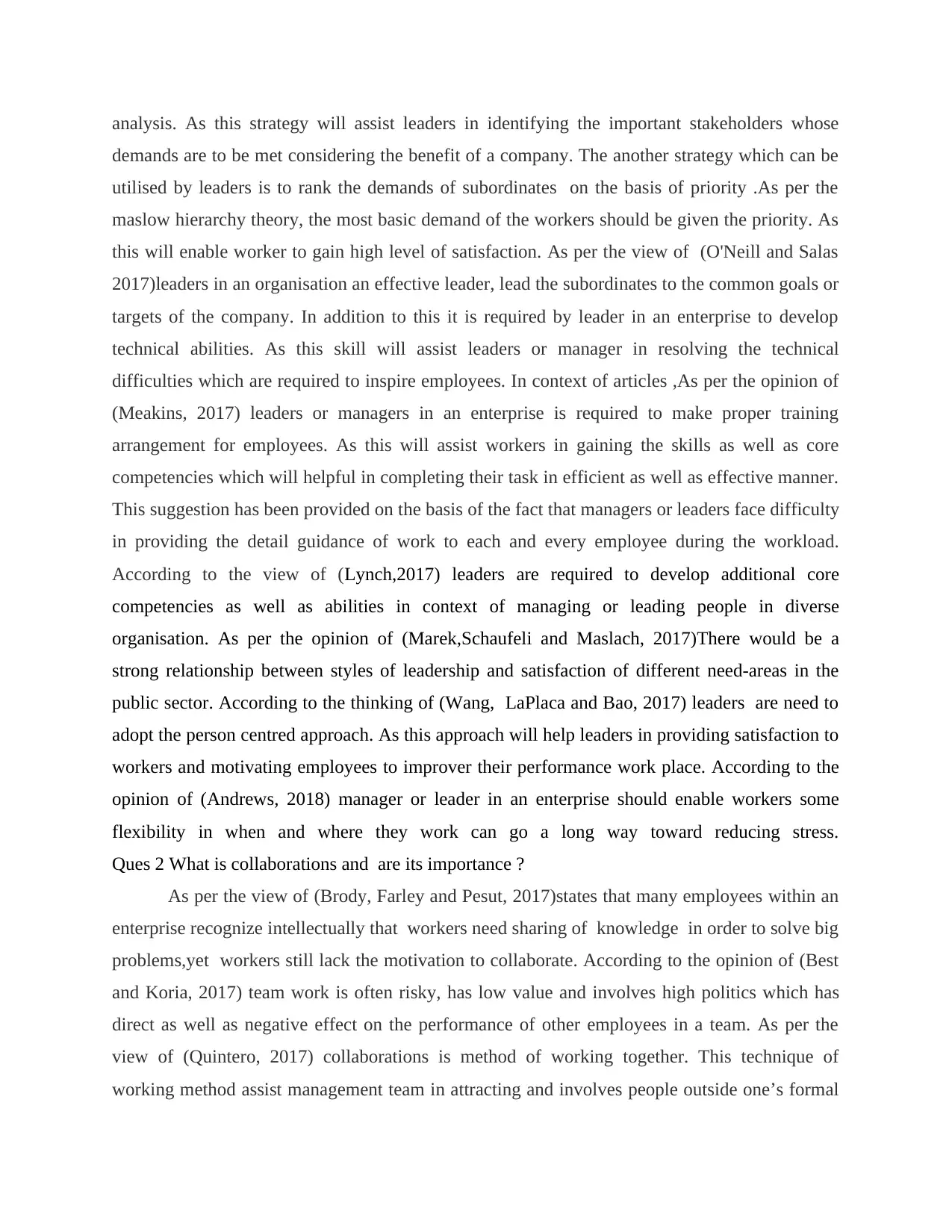
analysis. As this strategy will assist leaders in identifying the important stakeholders whose
demands are to be met considering the benefit of a company. The another strategy which can be
utilised by leaders is to rank the demands of subordinates on the basis of priority .As per the
maslow hierarchy theory, the most basic demand of the workers should be given the priority. As
this will enable worker to gain high level of satisfaction. As per the view of (O'Neill and Salas
2017)leaders in an organisation an effective leader, lead the subordinates to the common goals or
targets of the company. In addition to this it is required by leader in an enterprise to develop
technical abilities. As this skill will assist leaders or manager in resolving the technical
difficulties which are required to inspire employees. In context of articles ,As per the opinion of
(Meakins, 2017) leaders or managers in an enterprise is required to make proper training
arrangement for employees. As this will assist workers in gaining the skills as well as core
competencies which will helpful in completing their task in efficient as well as effective manner.
This suggestion has been provided on the basis of the fact that managers or leaders face difficulty
in providing the detail guidance of work to each and every employee during the workload.
According to the view of (Lynch,2017) leaders are required to develop additional core
competencies as well as abilities in context of managing or leading people in diverse
organisation. As per the opinion of (Marek,Schaufeli and Maslach, 2017)There would be a
strong relationship between styles of leadership and satisfaction of different need-areas in the
public sector. According to the thinking of (Wang, LaPlaca and Bao, 2017) leaders are need to
adopt the person centred approach. As this approach will help leaders in providing satisfaction to
workers and motivating employees to improver their performance work place. According to the
opinion of (Andrews, 2018) manager or leader in an enterprise should enable workers some
flexibility in when and where they work can go a long way toward reducing stress.
Ques 2 What is collaborations and are its importance ?
As per the view of (Brody, Farley and Pesut, 2017)states that many employees within an
enterprise recognize intellectually that workers need sharing of knowledge in order to solve big
problems,yet workers still lack the motivation to collaborate. According to the opinion of (Best
and Koria, 2017) team work is often risky, has low value and involves high politics which has
direct as well as negative effect on the performance of other employees in a team. As per the
view of (Quintero, 2017) collaborations is method of working together. This technique of
working method assist management team in attracting and involves people outside one’s formal
demands are to be met considering the benefit of a company. The another strategy which can be
utilised by leaders is to rank the demands of subordinates on the basis of priority .As per the
maslow hierarchy theory, the most basic demand of the workers should be given the priority. As
this will enable worker to gain high level of satisfaction. As per the view of (O'Neill and Salas
2017)leaders in an organisation an effective leader, lead the subordinates to the common goals or
targets of the company. In addition to this it is required by leader in an enterprise to develop
technical abilities. As this skill will assist leaders or manager in resolving the technical
difficulties which are required to inspire employees. In context of articles ,As per the opinion of
(Meakins, 2017) leaders or managers in an enterprise is required to make proper training
arrangement for employees. As this will assist workers in gaining the skills as well as core
competencies which will helpful in completing their task in efficient as well as effective manner.
This suggestion has been provided on the basis of the fact that managers or leaders face difficulty
in providing the detail guidance of work to each and every employee during the workload.
According to the view of (Lynch,2017) leaders are required to develop additional core
competencies as well as abilities in context of managing or leading people in diverse
organisation. As per the opinion of (Marek,Schaufeli and Maslach, 2017)There would be a
strong relationship between styles of leadership and satisfaction of different need-areas in the
public sector. According to the thinking of (Wang, LaPlaca and Bao, 2017) leaders are need to
adopt the person centred approach. As this approach will help leaders in providing satisfaction to
workers and motivating employees to improver their performance work place. According to the
opinion of (Andrews, 2018) manager or leader in an enterprise should enable workers some
flexibility in when and where they work can go a long way toward reducing stress.
Ques 2 What is collaborations and are its importance ?
As per the view of (Brody, Farley and Pesut, 2017)states that many employees within an
enterprise recognize intellectually that workers need sharing of knowledge in order to solve big
problems,yet workers still lack the motivation to collaborate. According to the opinion of (Best
and Koria, 2017) team work is often risky, has low value and involves high politics which has
direct as well as negative effect on the performance of other employees in a team. As per the
view of (Quintero, 2017) collaborations is method of working together. This technique of
working method assist management team in attracting and involves people outside one’s formal
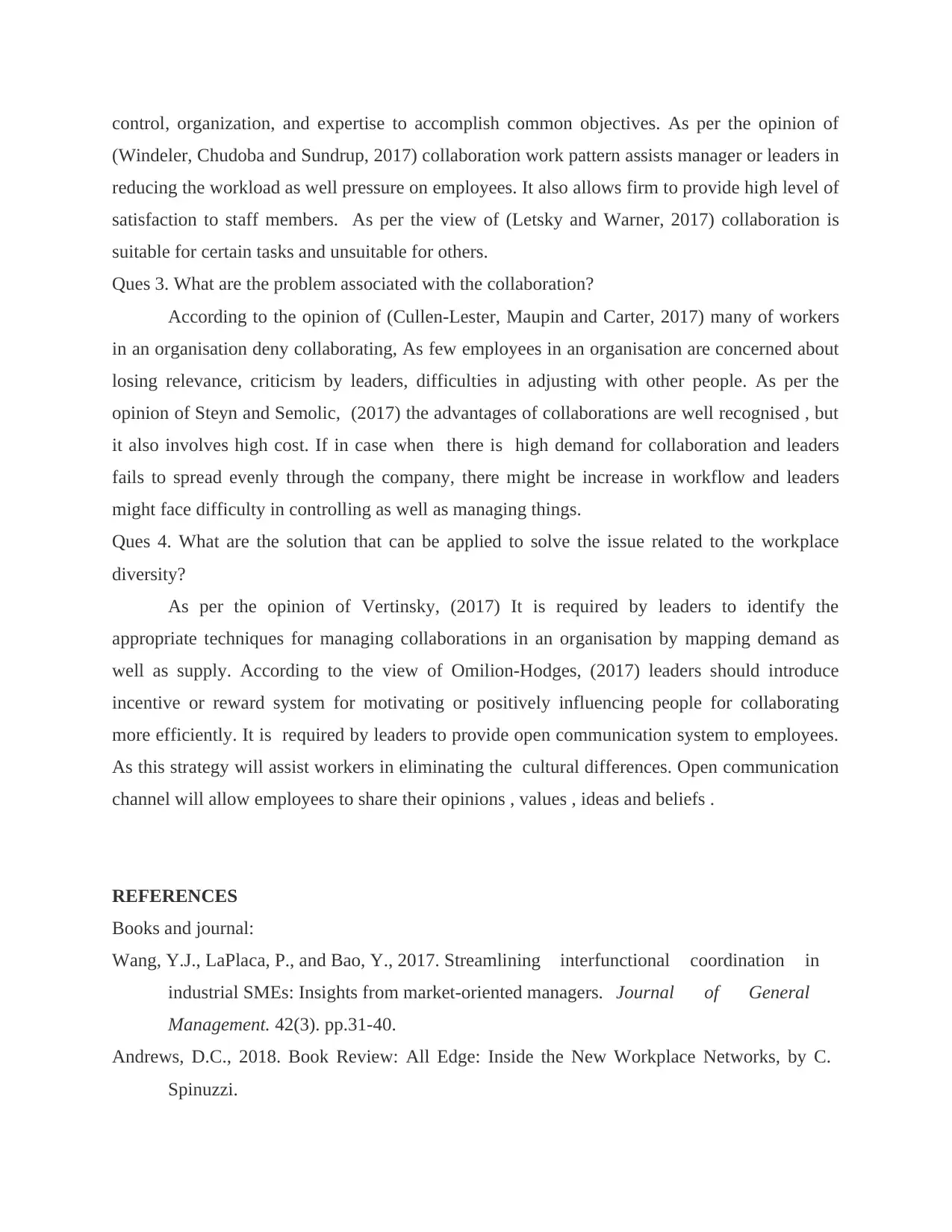
control, organization, and expertise to accomplish common objectives. As per the opinion of
(Windeler, Chudoba and Sundrup, 2017) collaboration work pattern assists manager or leaders in
reducing the workload as well pressure on employees. It also allows firm to provide high level of
satisfaction to staff members. As per the view of (Letsky and Warner, 2017) collaboration is
suitable for certain tasks and unsuitable for others.
Ques 3. What are the problem associated with the collaboration?
According to the opinion of (Cullen-Lester, Maupin and Carter, 2017) many of workers
in an organisation deny collaborating, As few employees in an organisation are concerned about
losing relevance, criticism by leaders, difficulties in adjusting with other people. As per the
opinion of Steyn and Semolic, (2017) the advantages of collaborations are well recognised , but
it also involves high cost. If in case when there is high demand for collaboration and leaders
fails to spread evenly through the company, there might be increase in workflow and leaders
might face difficulty in controlling as well as managing things.
Ques 4. What are the solution that can be applied to solve the issue related to the workplace
diversity?
As per the opinion of Vertinsky, (2017) It is required by leaders to identify the
appropriate techniques for managing collaborations in an organisation by mapping demand as
well as supply. According to the view of Omilion-Hodges, (2017) leaders should introduce
incentive or reward system for motivating or positively influencing people for collaborating
more efficiently. It is required by leaders to provide open communication system to employees.
As this strategy will assist workers in eliminating the cultural differences. Open communication
channel will allow employees to share their opinions , values , ideas and beliefs .
REFERENCES
Books and journal:
Wang, Y.J., LaPlaca, P., and Bao, Y., 2017. Streamlining interfunctional coordination in
industrial SMEs: Insights from market-oriented managers. Journal of General
Management. 42(3). pp.31-40.
Andrews, D.C., 2018. Book Review: All Edge: Inside the New Workplace Networks, by C.
Spinuzzi.
(Windeler, Chudoba and Sundrup, 2017) collaboration work pattern assists manager or leaders in
reducing the workload as well pressure on employees. It also allows firm to provide high level of
satisfaction to staff members. As per the view of (Letsky and Warner, 2017) collaboration is
suitable for certain tasks and unsuitable for others.
Ques 3. What are the problem associated with the collaboration?
According to the opinion of (Cullen-Lester, Maupin and Carter, 2017) many of workers
in an organisation deny collaborating, As few employees in an organisation are concerned about
losing relevance, criticism by leaders, difficulties in adjusting with other people. As per the
opinion of Steyn and Semolic, (2017) the advantages of collaborations are well recognised , but
it also involves high cost. If in case when there is high demand for collaboration and leaders
fails to spread evenly through the company, there might be increase in workflow and leaders
might face difficulty in controlling as well as managing things.
Ques 4. What are the solution that can be applied to solve the issue related to the workplace
diversity?
As per the opinion of Vertinsky, (2017) It is required by leaders to identify the
appropriate techniques for managing collaborations in an organisation by mapping demand as
well as supply. According to the view of Omilion-Hodges, (2017) leaders should introduce
incentive or reward system for motivating or positively influencing people for collaborating
more efficiently. It is required by leaders to provide open communication system to employees.
As this strategy will assist workers in eliminating the cultural differences. Open communication
channel will allow employees to share their opinions , values , ideas and beliefs .
REFERENCES
Books and journal:
Wang, Y.J., LaPlaca, P., and Bao, Y., 2017. Streamlining interfunctional coordination in
industrial SMEs: Insights from market-oriented managers. Journal of General
Management. 42(3). pp.31-40.
Andrews, D.C., 2018. Book Review: All Edge: Inside the New Workplace Networks, by C.
Spinuzzi.
⊘ This is a preview!⊘
Do you want full access?
Subscribe today to unlock all pages.

Trusted by 1+ million students worldwide
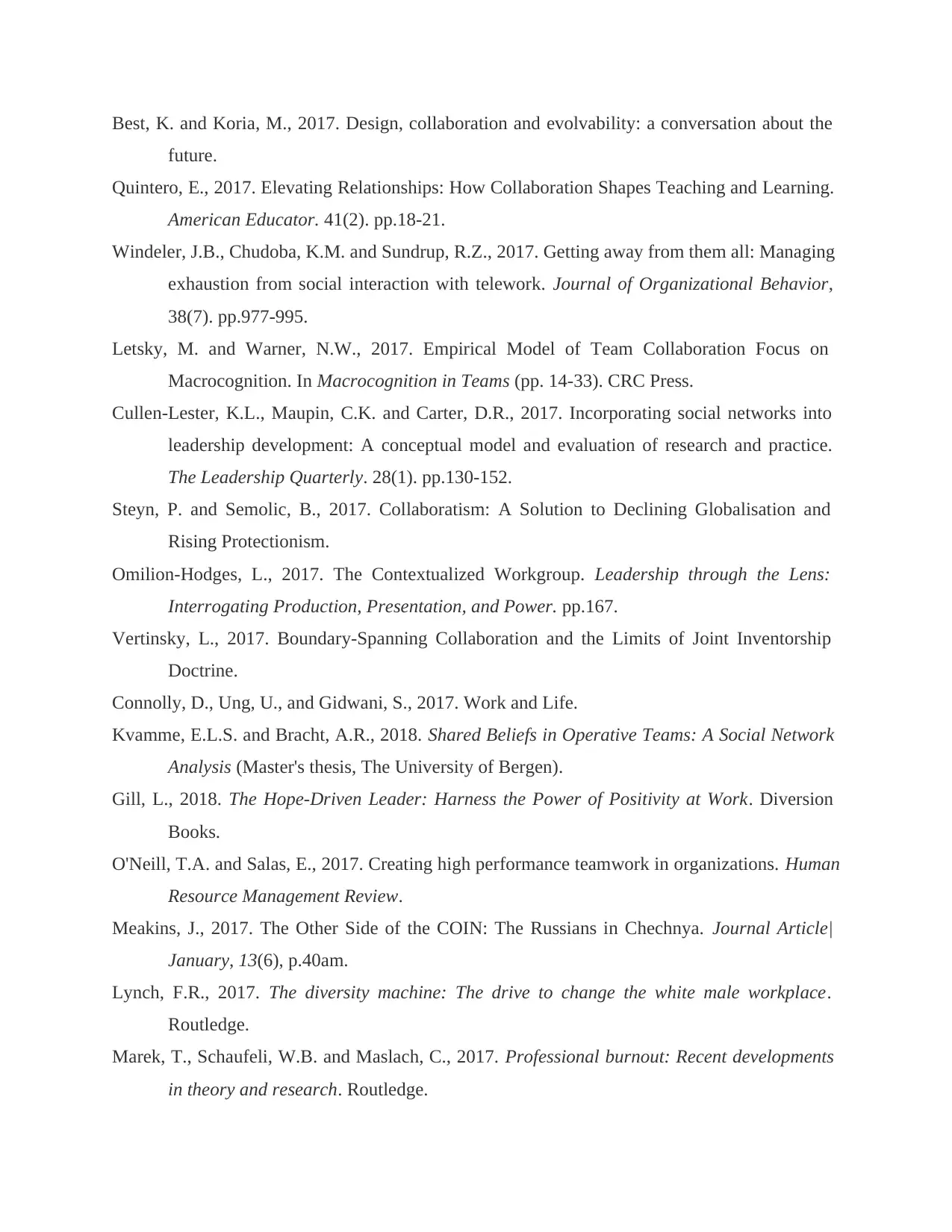
Best, K. and Koria, M., 2017. Design, collaboration and evolvability: a conversation about the
future.
Quintero, E., 2017. Elevating Relationships: How Collaboration Shapes Teaching and Learning.
American Educator. 41(2). pp.18-21.
Windeler, J.B., Chudoba, K.M. and Sundrup, R.Z., 2017. Getting away from them all: Managing
exhaustion from social interaction with telework. Journal of Organizational Behavior,
38(7). pp.977-995.
Letsky, M. and Warner, N.W., 2017. Empirical Model of Team Collaboration Focus on
Macrocognition. In Macrocognition in Teams (pp. 14-33). CRC Press.
Cullen-Lester, K.L., Maupin, C.K. and Carter, D.R., 2017. Incorporating social networks into
leadership development: A conceptual model and evaluation of research and practice.
The Leadership Quarterly. 28(1). pp.130-152.
Steyn, P. and Semolic, B., 2017. Collaboratism: A Solution to Declining Globalisation and
Rising Protectionism.
Omilion-Hodges, L., 2017. The Contextualized Workgroup. Leadership through the Lens:
Interrogating Production, Presentation, and Power. pp.167.
Vertinsky, L., 2017. Boundary-Spanning Collaboration and the Limits of Joint Inventorship
Doctrine.
Connolly, D., Ung, U., and Gidwani, S., 2017. Work and Life.
Kvamme, E.L.S. and Bracht, A.R., 2018. Shared Beliefs in Operative Teams: A Social Network
Analysis (Master's thesis, The University of Bergen).
Gill, L., 2018. The Hope-Driven Leader: Harness the Power of Positivity at Work. Diversion
Books.
O'Neill, T.A. and Salas, E., 2017. Creating high performance teamwork in organizations. Human
Resource Management Review.
Meakins, J., 2017. The Other Side of the COIN: The Russians in Chechnya. Journal Article|
January, 13(6), p.40am.
Lynch, F.R., 2017. The diversity machine: The drive to change the white male workplace.
Routledge.
Marek, T., Schaufeli, W.B. and Maslach, C., 2017. Professional burnout: Recent developments
in theory and research. Routledge.
future.
Quintero, E., 2017. Elevating Relationships: How Collaboration Shapes Teaching and Learning.
American Educator. 41(2). pp.18-21.
Windeler, J.B., Chudoba, K.M. and Sundrup, R.Z., 2017. Getting away from them all: Managing
exhaustion from social interaction with telework. Journal of Organizational Behavior,
38(7). pp.977-995.
Letsky, M. and Warner, N.W., 2017. Empirical Model of Team Collaboration Focus on
Macrocognition. In Macrocognition in Teams (pp. 14-33). CRC Press.
Cullen-Lester, K.L., Maupin, C.K. and Carter, D.R., 2017. Incorporating social networks into
leadership development: A conceptual model and evaluation of research and practice.
The Leadership Quarterly. 28(1). pp.130-152.
Steyn, P. and Semolic, B., 2017. Collaboratism: A Solution to Declining Globalisation and
Rising Protectionism.
Omilion-Hodges, L., 2017. The Contextualized Workgroup. Leadership through the Lens:
Interrogating Production, Presentation, and Power. pp.167.
Vertinsky, L., 2017. Boundary-Spanning Collaboration and the Limits of Joint Inventorship
Doctrine.
Connolly, D., Ung, U., and Gidwani, S., 2017. Work and Life.
Kvamme, E.L.S. and Bracht, A.R., 2018. Shared Beliefs in Operative Teams: A Social Network
Analysis (Master's thesis, The University of Bergen).
Gill, L., 2018. The Hope-Driven Leader: Harness the Power of Positivity at Work. Diversion
Books.
O'Neill, T.A. and Salas, E., 2017. Creating high performance teamwork in organizations. Human
Resource Management Review.
Meakins, J., 2017. The Other Side of the COIN: The Russians in Chechnya. Journal Article|
January, 13(6), p.40am.
Lynch, F.R., 2017. The diversity machine: The drive to change the white male workplace.
Routledge.
Marek, T., Schaufeli, W.B. and Maslach, C., 2017. Professional burnout: Recent developments
in theory and research. Routledge.
Paraphrase This Document
Need a fresh take? Get an instant paraphrase of this document with our AI Paraphraser
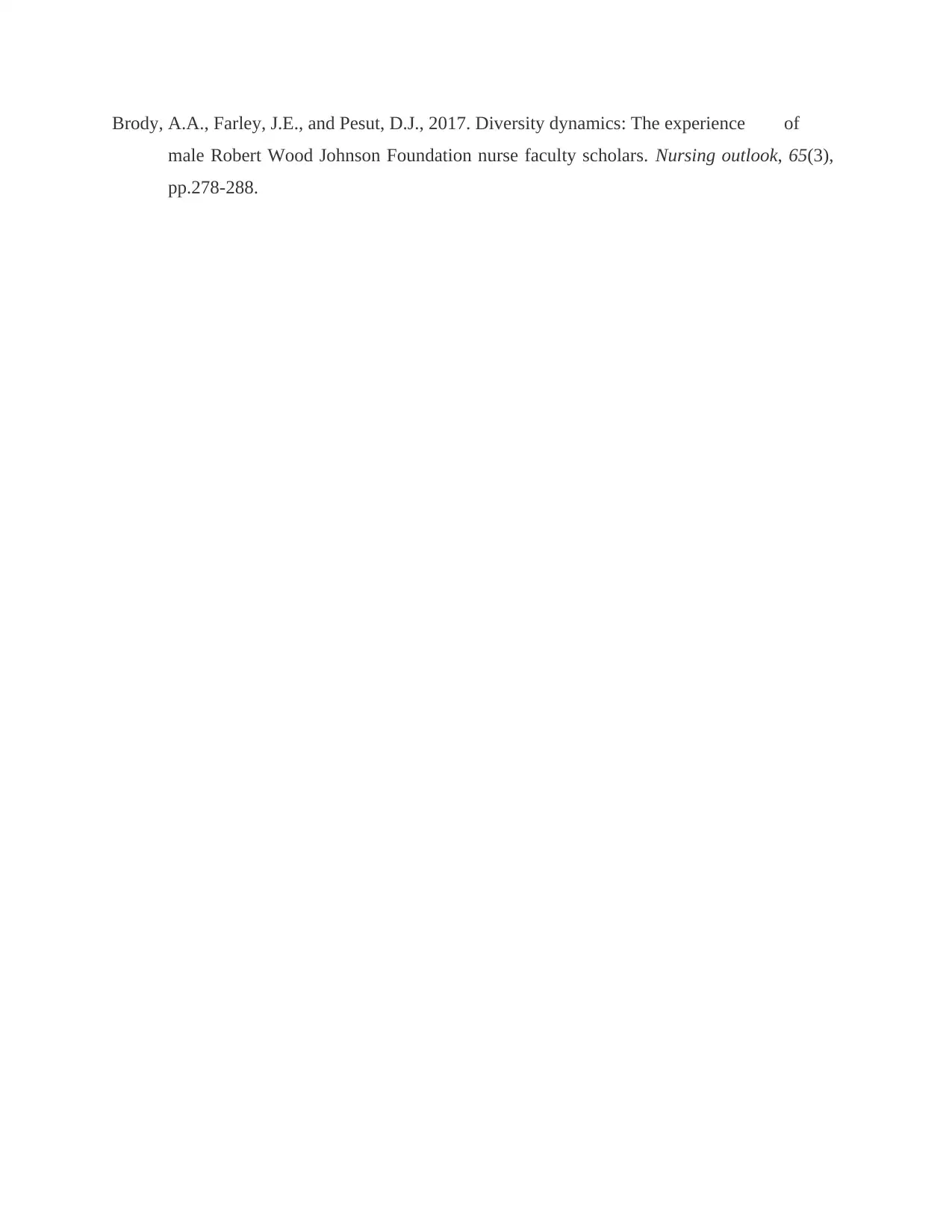
Brody, A.A., Farley, J.E., and Pesut, D.J., 2017. Diversity dynamics: The experience of
male Robert Wood Johnson Foundation nurse faculty scholars. Nursing outlook, 65(3),
pp.278-288.
male Robert Wood Johnson Foundation nurse faculty scholars. Nursing outlook, 65(3),
pp.278-288.
1 out of 8
Related Documents
Your All-in-One AI-Powered Toolkit for Academic Success.
+13062052269
info@desklib.com
Available 24*7 on WhatsApp / Email
![[object Object]](/_next/static/media/star-bottom.7253800d.svg)
Unlock your academic potential
Copyright © 2020–2025 A2Z Services. All Rights Reserved. Developed and managed by ZUCOL.





